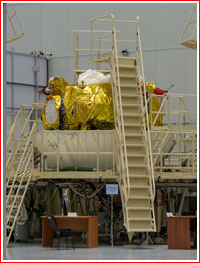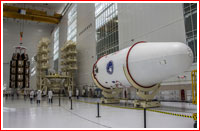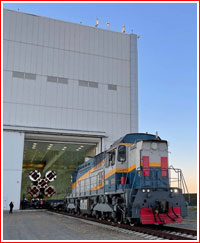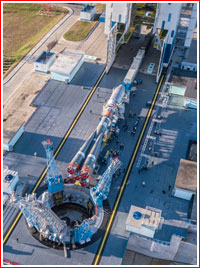| |
 |
|
|||||||||||||||||||||||||||||||||||||||||||||||||||||||||||||||||||||||||||||||||||||||||||||||||||||||||||||||||||||||||
Soyuz launches 11th OneWeb cluster A Soyuz-2-1b/Fregat rocket delivered a fresh batch of 36 satellites from Vostochny Cosmodrome on Oct. 14, 2021, for the UK-based OneWeb company. It was the seventh launch of the year into the OneWeb constellation, boosting it from 322 to 358 spacecraft or over the half of the planned 648 satellites.
The 11th Soyuz mission with OneWeb satellites at a glance:
Preparing the 11th OneWeb mission The 11th OneWeb mission, originally scheduled for launch on September 14, used a time slot that had been officially reserved for the Luna-Glob mission which had never had a real chance to fly in 2021. (INSIDER CONTENT) Once the Luna-Glob launch campaign was formally postponed until 2022, the available capacity at the Vostochny spaceport was provided for the OneWeb launch campaign. On Aug. 11, 2021, Roskosmos announced that the specialists of the joint team from the Vostochny branch of the TsENKI ground infrastructure center and NPO Lavochkin had removed the Fregat upper stage for the mission from its storage and installed it in the processing rig inside the Spacecraft Processing Building, MIK KO, of the center's processing complex. On September 1, Roskosmos said that pneumatic and electric tests of the Fregat had started on August 12 and were expected to be completed by September 6. At that time, the launch was already scheduled for October, according to Roskosmos. Fregat was transferred to the fueling station around September 7. The loading of propellant and pressurized gases aboard the upper stage was completed by September 30. An 124-100 transport plane delivered the 36 satellites for the mission to the Ignatievo airport in Blagoveshensk on Sept. 25, 2021. On October 6, the fully assembled satellite cluster was rolled inside the rocket's protective fairing, completing the assembly of the payload section. On October 8, the payload section was integrated with the launch vehicle and was ready for the rollout to the launch pad. The meeting of the State Commission authorizing the trip to the pad was scheduled for October 9, Roskosmos said. On October 11, at 7 a.m. local time in Vostochny (01:00 Moscow Time), the Soyuz-2-1b rocket with 36 OneWeb satellites started moving from the vehicle assembly building to the launch pad.
Countdown milestones for a typical OneWeb mission, according to Arianespace:
Launch profile of the OneWeb mission originating from Vostochny
Approximate ground track of the OneWeb mission. A Soyuz-2-1b rocket carrying a cluster of 36 OneWeb satellites lifted off from 1S pad in Vostochny on Oct. 14, 2021, at 12:40:10.356 Moscow Time (5:40 a.m. EDT). The ascent profile of the mission had a timeline and flight parameters similar to those employed in the previous OneWeb launches from Vostochny. After a few seconds of vertical ascent, the launch vehicle headed northward to align its ascent trajectory with a near-polar orbit inclined 87.4 degrees toward the plane of the Equator. The particular ground track employed during the ascent to orbit from Vostochny had so far been unique to OneWeb missions. The four boosters of the first stage separated 1 minute and 58 seconds after liftoff (L+117.8 sec.), but the core booster of the second stage continued firing until 4 minutes and 48 seconds into the flight (L+287.5 sec.). In the midst of its operation, the payload fairing protecting the payload in the dense atmosphere split into two halves and dropped off at L+3 minutes 35 seconds (L+215.2 sec.). Immediately after the separation of the second stage, the aft section of the third stage split into three fragments and separated at L+292.1 seconds. The fragments of the rocket were expected to fall at Drop Zones No. 873 and 875 in the Aldan and Kobyask Districts of the Sakha (Yakut) Republic in the Russian Far East. The third stage continued firing until 9 minutes and 22 seconds into the flight (T+559.2 seconds), releasing the Fregat upper stage and its cargo on a ballistic trajectory with an apogee of 249 kilometers, just short of orbital velocity at L+562.5 seconds. This allowed the third stage to reenter and fall back to Earth at a predicted remote area of the ocean instead of reaching orbit. Upper stage maneuvers
One minute after separation from the third stage, Fregat fired its main engine for 307 seconds to enter an elliptical (egg-shaped) 150 by 427-kilometer transfer orbit with the highest point (apogee) near the target altitude for the release of OneWeb satellites. After its first maneuver, Fregat climbed passively for nearly an hour. Soon after an orbital insertion, the space tug and its passengers left the communications range of ground stations for 1 hours 18 minutes and 42 seconds, therefore Fregat's second maneuver and the separation of the first batch of satellites took place out of contact with mission control. The restart of the Fregat's engine for a 31-second firing then happened near the apogee of the transfer orbit making it circular at an altitude of around 450 kilometers. The first quartet of OneWeb satellites was released in opposite directions from their dispenser 1 hour 18 minutes and 20 seconds after launch. It was followed by nearly 16 minutes later by a 15-second firing of the small attitude control thrusters, SOZ, aboard Fregat to get the vehicle in position for the second quartet drop around three minutes later. Roskosmos confirmed that the second quartet of satellites had been successfully deployed at 14:17 Moscow Time (7:17 a.m. EDT). Fregat was programmed to repeat its thruster firing and the four-satellite release routine seven more times, evenly distributing quartets of satellites along their orbit. Next time, the Fregat reentered the communications range, mission control confirmed that the 3rd, 4th, 5th and 6th batch of OneWeb satellites had indeed separated from their carrier. Then, still in direct view of ground stations, the 7th quartet also disembarked from the space tug. However, the vehicle then again went out of communications range for another 1 hour 18 minutes and 55 seconds. The final four of the 36 OneWeb passengers separated from their space tug 3 hours 51 minutes and 40 seconds after their liftoff from Vostochny. But the successful separation of the two final quartets of satellites would not be confirmed until sometimes later, when the empty Fregat stage reappeared in the view of ground stations. Around an hour after the release of its final passengers, Fregat was programmed to initiate a braking maneuver with its main engine designed to push the stage on a disposal orbit, resulting in its quick destruction in the upper atmosphere nearly six hours after launch over a remote area of the Pacific Ocean. In total, Fregat performed 11 active maneuvers: three with its main engine and eight firings of the SOZ attitude control thrusters. As in all previous missions, OneWeb satellites had to use their own electric propulsion systems to climb to an operational orbit of around 1,200 kilometers.
Timeline of a typical OneWeb mission from Vostochny:
|




|